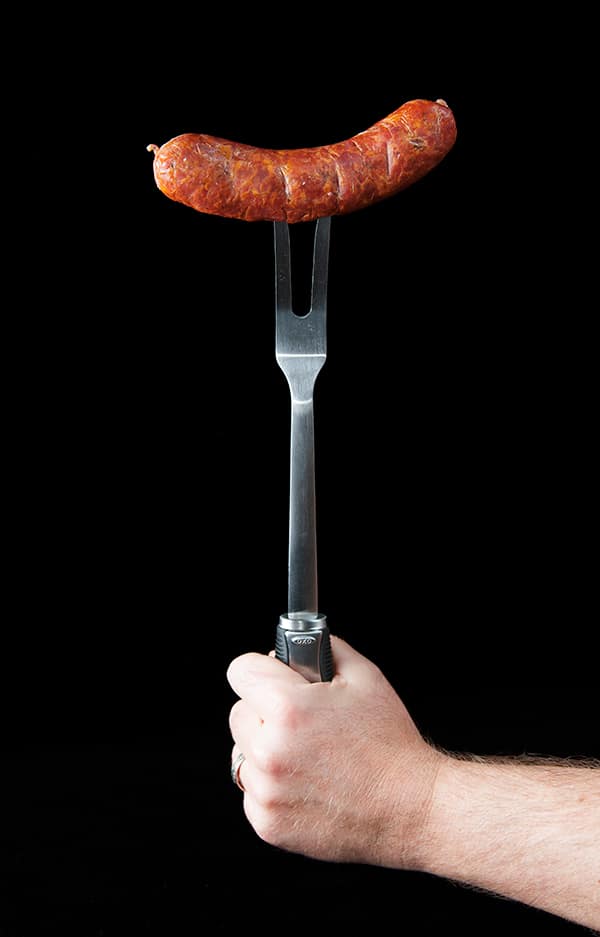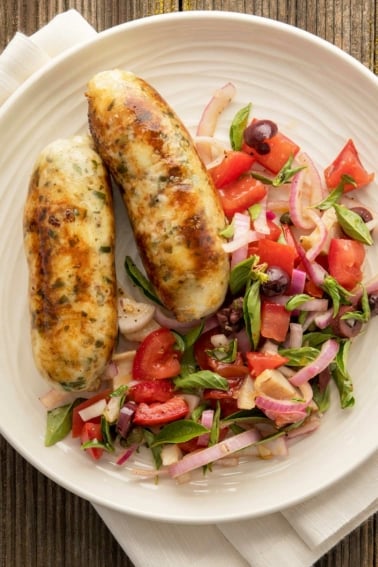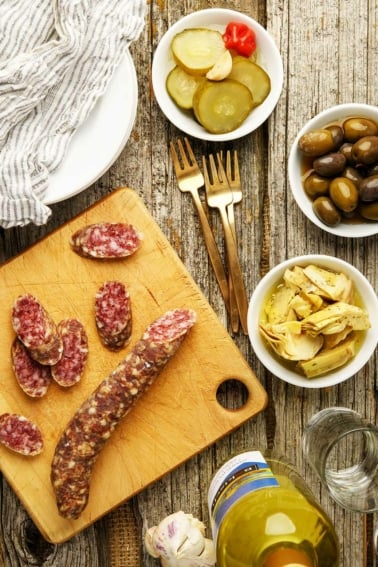As an Amazon Associate I earn from qualifying purchases.

Linguica. It’s part of the culinary fabric of California’s great Central Valley, available at every greasy spoon from Redding to Bakersfield, served at breakfast, lunch and dinner. You can thank the Azoreans for this one.
I’ve heard tell that there are more Azoreans in California than there are in the Azores, which, if you are not familiar, are a small chain of islands off the coast of Portugal. You can see their names everywhere around here: Silva, Lopes, Mendes, Machado, Costa, Cardoza. Linguica eaters, all.
What is this strange sausage of which I speak? Linguica (Ling-GWEE-zuh) is a pork sausage heavily spiced with paprika, chiles and garlic. There are all sorts of variations, but linguica is normally a coarse, country sausage, and it is often smoked. I’ve eaten linguica all over the country, but the best have been in Gloucester, Massachusetts (where my mother and sister live), and here in the Valley.
A really good linguica, to my mind, is a cudgel of a sausage. Smoky, garlicky and rich with pork fat and red peppers, it is spectacular served with grilled onions on a hoagie roll. A man’s sandwich.
The Portuguese put linguica in almost everything, but in addition to sandwiches, I love it in soups with Portuguese cabbage (which is a lot like our collard greens) and potatoes. My friend David Leite has several good recipes using linguica in his cookbook The New Portuguese Table.
I made my version with wild pig. Of course if you can’t get wild boar, you can use pork. But use good-quality pork from a good butcher or a farmer’s market. I suppose you could also use bear, too, if you have that lying around.
If you’ve never made sausage before, start by reading this detailed tutorial on how to make sausages at home.
Portuguese Linguica
Ingredients
- 3 1/2 pounds pork shoulder or wild boar meat
- 1 1/2 pounds pork fat
- 34 grams kosher salt
- 6 grams Instacure No. 1 (optional)
- 1 tablespoon dextrose or white sugar
- 10 garlic cloves, minced
- 1 tablespoon sweet paprika
- 1 teaspoon hot paprika or cayenne
- 1 teaspoon smoked paprika (optional)
- 1 tablespoon dried oregano
- 1 tablespoon crushed black pepper
- 1/2 cup dry milk (optional - it helps the sausage retain moisture while smoking)
- 3/4 cup red wine, preferably a Portuguese wine
- Hog casings
Instructions
- Chill the meat and fat until they're almost frozen by putting it in the freezer for an hour or so.
- Take out some hog casings -- you'll need about 3 to 4 standard lengths, about 15 feet -- and set in a bowl of very warm water.
- Chop meat and fat into chunks that will fit into your grinder. Combine the salt, instacure (if using), sugar, garlic, dry milk and the rest of the spices and mix it into the meat and fat with your hands. Let this rest in the fridge for about an hour. (Optional expert step: Mix the chunks of meat and fat with the salt and curing salt overnight before proceeding. Doing this will give you a better bind on the sausage.)
- Grind through your meat grinder using the coarse die, about 6.5 mm or so. If your room is warmer than 69°F, set the bowl for the ground meat into another bowl of ice to keep it cold. Put the mixture back in the freezer while you clean up.
- Add the wine to the meat mix, then mix thoroughly either using a Kitchenaid on low for 60-90 seconds or with your (very clean) hands. This is important to get the sausage to bind properly. Once it is mixed well, put it back in the fridge while you clean up again.
- Stuff the sausage into the casings. Do whole coils before making links. Twist off links by pinching the sausage down and twisting it, first in one direction, and then with the next link, the other direction. (Here's a quick video on making the links) Or you could tie them off with butcher’s string.
- Hang the sausages in a cool place. If it is warm out or if you are smoking your links, hang for one hour. If you have a place where the temperature will not go higher than 38°F, you can hang them as long as overnight.
- If you are smoking your sausages, get your smoker going while the sausages hang. Smoke the links for at least 3 hours, and as many as 12. I prefer a lighter smoke, so you can still taste the pork and spices. I prefer oak, but hickory, maple, pecan or a fruit wood would also work.
- Once the sausages have dried and/or smoked, put them the fridge until needed. If you are freezing the sausages, wait a day before doing so. This will tighten up the sausages and help them keep their shape in the deep-freeze.
Notes
Nutrition
Nutrition information is automatically calculated, so should only be used as an approximation.





The difference between linguica and chourico is just what animal casing is used
YooperDog: I hot-smoke this sausage. I agree with your temps, although I would pull the sausage when it gets to an internal temp of 155 degrees, plenty hot enough to kill any parasites or bad bugs. 165 is an old USDA temperature guide…
At what temps do you smoke your linguica sausage? Cold or hot smoke? I didn’t use the instacure as I will vacuum seal and freeze for later use. My understanding is that you would want to hot smoke around 150-190 F until internal temp reaches at least 165 F, chill then freeze; then cook the sausage as normal to ensure food safety. My experience smoking/cooking sausage is limited to BBQ style where I run the smoker at a higher temp to cook the sausage after the initial smoke.
thanks for posting this Portuguese Sausage making information, I too am Azoreean from the Californa vally love the Linguica, I now live in the northwest of south Carolina and I can get it in Publiix stores and the we can get the other type on Portuguese sausage, not blood sausage, My mom lived in Martica and was able to get it from a mom and pop store there, man it was the best ever.
Davi
Absolutly love the recipe, made it once so far and a huge hit. I added a little more heat and it was great. Thanks for sharing the ideas. My mom always taught us to add sour orange and chunk the meat into quarter inch chunks – comes out killer but a lot more work. You run it through the grinder minus the blade or stuff by hand.
Respectfully. John Brasil
Mosaica: Yep, good catch! I fixed the recipe.
Hello Hank,
Very nice post, as ever. I’m guessing that you meant 3/4 or .75 cup wine, not 3.4 cups, right? I’m 99% sure, but reckoned I’d double check. Thanks!
Hank, this looks amazing. The other half of Chez Us is Portuguese, 1st generation. His parents came over from Sao Miguel, Azores, 40 years ago; he grew up eating Linguica as well as Chorizo. My background is Spanish Basque, and we grew up on Basque Chorizo. Both are delicious, very different in taste, and texture. I asked Laudalino, what he thought the difference was between chorizo and linguica. He said that it really comes down to texture. Linguica is ground more, so it is finer, not crumbly like Mexican Chorizo, but close; as well it is smoked. Chorizo has a meater texture, and usually is not smoked. I find that the Basque chorizo, I grew up on, are spicier than Portuguese. I think that all depends on who makes it, as sometimes, we get some pretty spicy Portuguese chorizo when we are back in Boston. Even Montreal has a huge Portuguese community, and we have had some really delicious chorizo from there.
Hank, Laudalino, is wondering how he can get his hands on some of this home-made sausage. Are you selling it? He even said he would drive up to Sac to get it! 🙂
A goal this year is to learn to make chorizo, as we cannot find good Portuguese or Basque chorizo in the Bay Area.
My neighborhood here in Somerville, MA is all Azorean Portuguese, full of shops that sell their own house-made linguica. But that’s not going to stop me from trying it on my own.
I’d love to meet up with you when you’re out here for your book tour, if your schedule permits.
Right on!
I went to school in Rhode Island and seem to remember that this sausage goes best with Haffenreffer (cheap beer). It was college cut me some slack.
I love all forms of charcuterie and have recently been on a course for bacon and ham curing, next course is air dried meats. Love the sound of these sausages.
Ian
Sweet, thanks for the heads up.
Glad your site is back up too. Sniper!
Mike: I’ve not done this sausage with vinegar, but I do make lots of sausages using vinegar as the liquid. Definitely adds something to the flavor.
Rachel: Hope you like my version of that stew…
Elizabeth: Chourico never has blood, in my experience. That is morcella. As for its differences with linguica, heat might be one difference, but I am pretty sure linguica is always more garlicky than chourico. Anyone else want to chime in on this one?
Marshall: I hang every fresh sausage I make. Even a brief hang lets the sausage drain off any excess moisture. It helps locate air pockets, which you need to prick with a pin (or risk a bursting casing when you cook). Hanging will also tighten the meat within the casing, and will partially dry it out, concentrating flavors.
Mel: You got that right! A combination of Portuguese and Mexican is pretty much ideal.
Ah yes, I come from Tulare, where if you’re not Portuguese or Mexican, you’re in a minority. Luckily, the majorities provide some delicious food, especially linguicas & chorizos…
Thanks for the wonderful blog. I wish I’d found you when I was back in school at UC Davis. I lament I did not make use of the bounty down there when it was right in front of me. (Luckily, I live in Seattle now, and different, equally delicious foods abound).
Hey Hank.
I’ve noticed the hanging requirement in your directions. What does that do?
Note, we did not hang the mazzafegatti last week.
Looks great! It wasn’t until I lived in Oakland that I learned of this fine sausage. My friends were appalled! We would drive out to diners in Contra Costa to search them out.
I’ve still got about 100 yards of casings, so thanks for this inspiration
This is similar to the chourico I make. I’ve never been sure of the traditional differences. Some sources say chourico has more heat, and a Portugese woman in Sacto told me that chourico usually has blood. (I thought that was only when it was called “mouro.”) May be geographic?
Man’s sandwich, huh? I’ll be working on my Jim Harrison impression.
I am visiting the south shore of Boston right now and ate liguica today in a kale soup, as is traditional in many restaurants around here run by Portuguese immigrants. It was fantastic!
Terrific, I love Linquica. I’m so glad you posted this, I haven’t found much in the way of recipes. I will make these. Have you tried them with vinegar? Some of the ones I’ve tried have a hint of vinegar in them, but I can’t say they were better than the others, just different.